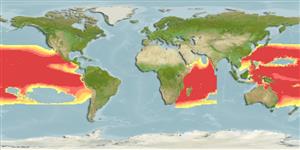Actinopterygii (ray-finned fishes) >
Perciformes (Perch-likes) >
Bramidae (Pomfrets)
Etymology: Eumegistus: Greek, eu = good + Greek , megistos, -e, -on = very big, powerfull (Ref. 45335). More on author: Jordan.
Environment / Climate / Range
Ecology
Marine; bathypelagic; depth range 1 - 520 m (Ref. 58302). Deep-water, preferred ?
Pacific Ocean: Okinawa (Ryukyu Islands), Fiji and Tuvalu (Ref. 12596), Hawaii. Indian Ocean: western part of equatorial zone.
Size / Weight / Age
Maturity: Lm ? range ? - ? cm
Max length : 47.0 cm SL male/unsexed; (Ref. 559)
Dorsal
spines
(total): 0;
Dorsal
soft rays
(total): 33-35;
Anal
spines: 0;
Anal
soft rays: 24;
Vertebrae: 17 - 23. Body color dark-brown to black. Scales on body and head spineless. Scaleless areas above and behind the eye. Caudal fin rounded in young and juveniles, forked in adults. Attains 47 cm SL.
Benthopelagic (Ref. 58302).
Life cycle and mating behavior
Maturity | Reproduction | Spawning | Eggs | Fecundity | Larvae
Masuda, H., K. Amaoka, C. Araga, T. Uyeno and T. Yoshino, 1984. The fishes of the Japanese Archipelago. Vol. 1. Tokai University Press, Tokyo, Japan. 437 p. (text). (Ref. 559)
IUCN Red List Status (Ref. 115185)
CITES (Ref. 94142)
Not Evaluated
Threat to humans
Harmless
Human uses
More information
Common namesSynonymsMetabolismPredatorsEcotoxicologyReproductionMaturitySpawningFecundityEggsEgg development
ReferencesAquacultureAquaculture profileStrainsGeneticsAllele frequenciesHeritabilityDiseasesProcessingMass conversion
Tools
Special reports
Download XML
Internet sources
Estimates of some properties based on models
Phylogenetic diversity index (Ref.
82805): PD
50 = 0.7500 [Uniqueness, from 0.5 = low to 2.0 = high].
Bayesian length-weight: a=0.01413 (0.00734 - 0.02718), b=2.95 (2.77 - 3.13), in cm Total Length, based on LWR estimates for this species & (Sub)family-body (Ref.
93245).
Trophic Level (Ref.
69278): 4.2 ±0.6 se; Based on size and trophs of closest relatives
Resilience (Ref.
69278): Low, minimum population doubling time 4.5 - 14 years (Preliminary K or Fecundity.).
Vulnerability (Ref.
59153): High vulnerability (58 of 100) .
